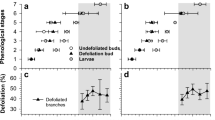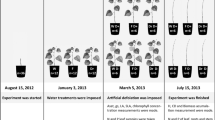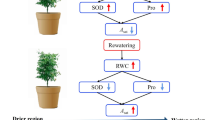Abstract
Physiological mechanisms behind plant–herbivore interactions are commonly approached as input–output systems where the role of plant physiology is viewed as a black box. Studies evaluating impacts of defoliation on plant physiology have mostly focused on changes in photosynthesis while the overall impact on plant water relations is largely unknown. Stem hydraulic conductivity (k h), stem specific conductivity (k s), percent loss of hydraulic conductivity (PLC), CO2 assimilation (A) and stomatal conductance (g s) were measured on well-irrigated 1-month-old Populus tremuloides (Michx.) defoliated and control seedlings until complete refoliation. PLC values of defoliated seedlings gradually increased during the refoliation process despite them being kept well irrigated. k s of defoliated seedlings gradually decreased during refoliation. PLC and k s values of control seedlings remained constant during refoliation. k s of new stems, leaf specific conductivity and A of leaves grown from new stems in defoliated and control seedlings were not significantly different, but g s was higher in defoliated than in control seedlings. The gradual increase of PLC and decrease of k s values in old stems after defoliation was unexpected under well-irrigated conditions, but appeared to have little impact on new stems formed after defoliation. The gradual loss of conductivity measured during the refoliation process under well-irrigated conditions suggests that young seedlings of P. tremuloides may be more susceptible to cavitation after herbivore damage under drought conditions.





Similar content being viewed by others
References
Alward RD, Joern A (1993) Plasticity and overcompensation in grass responses to herbivory. Oecologia 95:358–364
Améglio T, Bodet C, Lacointe A, Cochard H (2002) Winter embolism, mechanisms of xylem hydraulic conductivity recovery and springtime growth patterns in walnut and peach trees. Tree Physiol 22:1211–1220
Avila-Sakar G, Leist LL, Stephenson AG (2003) Effects of the spatial pattern of leaf damage on growth and reproduction: nodes and branches. J Ecol 91:867–879
Baraza E, Zamora R, Hodar JA (2006) Conditional outcomes in plant–herbivore interactions: neighbors matter. Oikos 113:148–156
Delaney KJ (2008) Injured and uninjured leaf photosynthetic responses after mechanical injury on Nerium oleander leaves, and Danaus plexippus herbivory on Asclepias curassavica leaves. Plant Ecol 199:187–200
Freeman RS, Brody AK, Neefus CD (2003) Flowering phenology and compensation for herbivory in Ipomopsis aggregata. Oecologia 136:394–401
Gálvez DA, Cohen-Fernández A (2006) Partial compensation in Psychotria marginata (Rubiaceae) after simulated defoliation increases photon capture and photosynthesis. Photosynthetica 44:46–52
Givnish TJ (1986) On the economy of plant form and function. Cambridge University Press, Cambridge, UK
Hanley ME, May OC (2006) Cotyledon damage at the seedling stage affects growth and flowering potential in mature plants. New Phytol 169:243–250
Hawkes CV, Sullivan JJ (2001) The impact of herbivory on plants in different resource conditions: a meta-analysis. Ecology 82:2045–2058
Johnston DB, Cooper DJ, Thompson Hobbs N (2007) Elk browsing increases aboveground growth of water-stressed willows by modifying plant architecture. Oecologia 154:467–478
Landhäusser SM, Lieffers VJ (2003) Seasonal changes in carbohydrate reserves in mature northern Populus tremuloides clones. Trees Struct Funct 17:471–476
Lasseur B, Lothier J, Morvan-Bertrand A, Escobar-Gutierrez A, Humphreys MO, Prud’homme MP (2007) Impact of defoliation frequency on regrowth and carbohydrate metabolism in contrasting varieties of Lolium perenne. Funct Plant Biol 34:418–430
Levine MT, Paige KN (2004) Direct and indirect effects of drought on compensation following herbivory in scarlet gilia. Ecology 85:3185–3191
Mayr S, Rothart B, Wolfschwenger M (2006) Temporal and spatial pattern of embolism induced by pressure collar techniques in twigs of Picea abies. J Exp Bot 57:3157–3163
Meinzer FC, Goldsmith G, Neufeld HS, Grantz DA, Crisosto GM (1992) Hydraulic architecture of sugarcane in relation to patterns of water use during plant development. Plant Cell Environ 15:471–477
Meyer GA (1998) Pattern of defoliation and its effect on photosynthesis and growth of goldenrod. Funct Ecol 12:270–279
Nowak RS, Caldwell MM (1984) A test of compensatory photosynthesis in the field: implications for herbivory tolerance. Oecologia 61:311–318
Paige KN, Whitham TG (1987) Overcompensation in response to mammalian herbivory: the advantage of being eaten. Am Nat 143:739–749
Palacio S, Hester AJ, Maestro M, Millard P (2008) Browsed Betula pubescens trees are not carbon-limited. Funct Ecol 22:808–815
Philip JR (1966) Plant water relations: some physical aspects. Annu Rev Plant Physiol 17:245–268
Pulice CE, Packer AA (2008) Simulated herbivory induces extrafloral nectary production in Prunus avium. Funct Ecol 22:801–807
Ren Z, Sucoff E (1995) Water movement trough Quercus rubra L. Leaf water potential and conductance during polycyclic growth. Plant Cell Environ 18:447–453
Ruiz-R N, Ward D, Saltz D (2008) Leaf compensatory growth as a tolerance strategy to resist herbivory in Pancratium sickenbergeri. Plant Ecol 198:19–26
Sperry JS, Donnelly JR, Tyree MT (1988a) A method for measuring hydraulic conductivity and embolism in xylem. Plant Cell Environ 11:35–40
Sperry JS, Donnelly JR, Tyree MT (1988b) Seasonal occurrence of xylem embolism in sugar maple (Acer saccharum). Am J Bot 75:1212–1218
Sperry JS, Adler FR, Campbell GS, Comstock JP (1998) Limitation of plant water use by rhizosphere and xylem conductance: results from a model. Plant Cell Environ 21:347–359
Staley JT, Mortimer SR, Masters GJ, Morecroft MD, Brown VK, Taylor ME (2006) Drought stress differentially affects leaf-mining species. Ecol Entomol 31:460–469
Stevens MT, Waller DM, Lindroth RL (2007) Resistance and tolerance in Populus tremuloides: genetic variation, cost, and environmental dependency. Evol Ecol 21:829–847
Stevens MT, Kruger EL, Lindroth RL (2008) Variation in tolerance to herbivory is mediated by differences in biomass allocation in aspen. Funct Ecol 22:40–47
Thomson VP, Cunningham SA, Ball MC, Nicotra AB (2003) Compensation for herbivory by Cucumis sativus through increased photosynthetic capacity and efficiency. Oecologia 134:167–175
Tiffin P (2000) Mechanisms of tolerance to herbivore damage: what do we know? Evol Ecol 14:523–536
Tyree MT (2002) Hydraulic limits on tree performance: transpiration, carbon gain and growth of trees. Land Use Water Resour Res 2:3.1–3.7
Tyree MT, Ewers FW (1991) The hydraulic architecture of trees and other woody plants. New Phytol 119:345–360
Tyree MT, Sperry JS (1988) Do woody plants operate near the point of catastrophic xylem dysfunction caused by dynamic water stress? Plant Phys 88:574–580
Tyree MT, Sperry JS (1989) Vulnerability of xylem to cavitation and embolism. Annl Rev Plant Phys 40:19–38
Tyree MT, Zimmermann MH (2002) Xylem structure and the ascent of sap. Springer-Verlag, New York, USA
Valladares F, Skillman JB, Pearcy RW (2002) Convergence in light capture efficiencies among tropical forest understory plants with contrasting crown architectures: a case of morphological compensation. Am J Bot 89:1275–1284
van Staalduinen MA, Anten NPR (2005) Differences in the compensatory growth of two co-occurring grass species in relation to water availability. Oecologia 146:190–199
Wise MJ, Abrahamson WG (2005) Beyond the compensatory continuum: environmental resource levels and plant tolerance of herbivory. Oikos 109:417–428
Zhao W, Chen S, Lin G (2008) Compensatory growth responses to clipping defoliation in Leymus chinensis (Poaceae) under nutrient addition and water deficient conditions. Plant Ecol 196:85–99
Acknowledgments
We thank Dr Erbilgin Nadir and Dr Simon Landhäusser in the Department of Renewable Resources at the University of Alberta for helpful comments on an early manuscript. We thank the staff at the Ag/For Greenhouse Facilities, particularly Bruce Alexander for providing critical information on aspen nursing. D. A. G. thanks Mallory Jackson for helpful comments and editorial skills and Paloma Olea Cohen for help with plant material. The authors also thank the two anonymous reviewers, whose comments were valuable in the improvement of this paper.
Author information
Authors and Affiliations
Corresponding author
Additional information
Communicated by Zoe Cardon.
Rights and permissions
About this article
Cite this article
Gálvez, D.A., Tyree, M.T. Impact of simulated herbivory on water relations of aspen (Populus tremuloides) seedlings: the role of new tissue in the hydraulic conductivity recovery cycle. Oecologia 161, 665–671 (2009). https://doi.org/10.1007/s00442-009-1416-8
Received:
Accepted:
Published:
Issue Date:
DOI: https://doi.org/10.1007/s00442-009-1416-8




